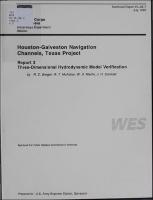Please use this identifier to cite or link to this item:
https://hdl.handle.net/11681/12386| Title: | Houston-Galveston Navigation Channels, Texas Project Report 3, Three-dimensional hydrodynamic model verification |
| Authors: | United States. Army. Corps of Engineers. Galveston District Berger, Rutherford C. McAdory, Robert T. Martin, William D. Schmidt, Joseph H. |
| Keywords: | Navigation Three-dimensional Numerical model Tides Salinity Estuary Salinity intrusion Velocity Flow Galveston Bay (Tex.) Navigation channels Channelization RMA10-WES (computer program) Mathematical models |
| Publisher: | Hydraulics Laboratory (U.S.) Engineer Research and Development Center (U.S.) |
| Series/Report no.: | Technical report (U.S. Army Engineer Waterways Experiment Station) ; HL-92-7 rept. 3. |
| Description: | Technical Report Abstract: This report describes the verification results of the three-dimensional (3-D) hydrodynamic model used to evaluate tides, current velocities, and salinities in Galveston Bay, Texas. This is the third in a series of reports concerning the Houston-Galveston Navigation Channels The goal of these reports is to determine the effect of the proposed channel deepening and widening upon tides, currents salinities, and navigation. Report 1 describes the field data collection and results, Report 2 presents the two-dimensional numerical modeling of hydrodynamics for a navigation study. Report 3 presents the verification description for the 3-D model, and Report 4 details the results or tests of the 3-D model. This report first describes the 3-D model program, RMA10-WES, which is a finite element code using mixed quadratic and linear Lagrange polynomials. The remainder of the report reveals the demonstration of the model applicability through the verification procedure. This procedure of adjustment and verification was first a comparison to a short series of data with a series of adjustments in bed roughness. Then the model was run with no adjustment over a period of roughly 6 months in comparison to field data from 19 July 1990 to 15 January 1991. This period includes the time following a major flood in the Galveston Bay system for which the model reproduces the timing and magnitude of the salinity rebound very well. Comparisons of model performance are drawn qualitatively between the model and description of the Bay in the literature, and also quantitatively with the field data recorded for this study. NOTE: This is large. Allow your browser several minutes to download the file. |
| Rights: | Approved for public release; distribution is unlimited. |
| URI: | http://hdl.handle.net/11681/12386 |
| Appears in Collections: | Technical Report |
Files in This Item:
| File | Description | Size | Format | |
|---|---|---|---|---|
| TR-HL-92-7-V3.pdf | 14.74 MB | Adobe PDF |  View/Open |